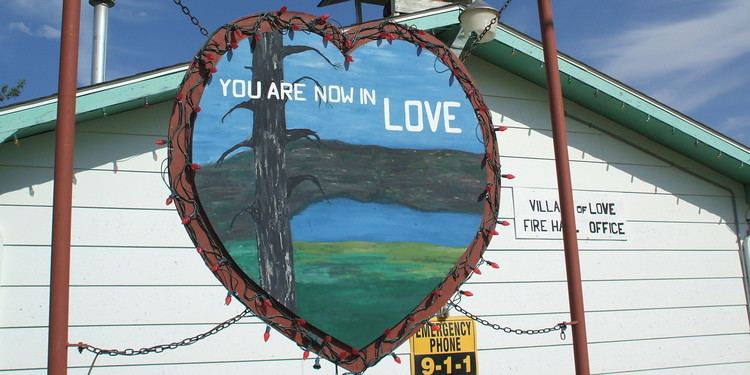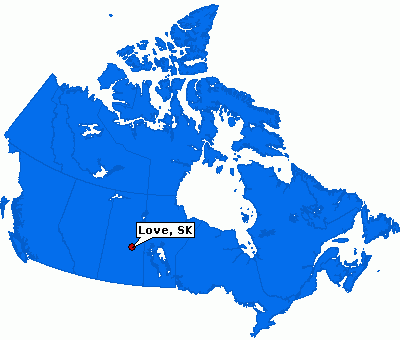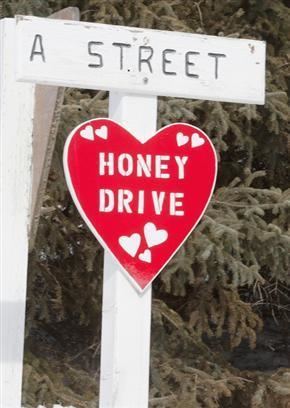Country Canada Census division 6 Post office Founded 1935 Area 128 ha Area code 306 | Time zone CST Population 65 (2011) | |
 | ||
Weather -12°C, Wind SE at 14 km/h, 69% Humidity | ||
Love saskatchewan revisited
Love is a small village in the province of Saskatchewan, northeast of Prince Albert.
Contents
It is known for its unique name and a special postmark, which is a teddy bear holding a heart.

History
(Information gleaned from the Love history book "Love At First Site" and interviews with residents.)

The village of Love, Saskatchewan got its start in 1934 with the building of a general store by William (Bill) Sears with the assistance of Emery Long. The store was built on the north side of the Canadian Pacific Railway tracks which came through the area in 1929. In 1935 a post office was established in Sear's Store with Mr. Sears as postmaster.

The first houses were built by Eldon Lamb and Walter and Myrtle Haight and in 1936 Grant and Ray Emery built a general store for Lamb and Earl Johnston who were operating a lumber mill and planer nearby. Since the mill operated all year round, many of the employees built homes (usually little more than shacks) and moved their families to the fledgling community. In the beginning there was no town-site laid out so the homes were built helter‑skelter wherever there was room.

In 1939 the provincial government offered 35 acres (140,000 m2) for sale on the east side of the SW‑16‑52‑15‑W2. Because the homeowners wanted title to their property the Love Development Company was formed to tender a bid on the land. They were successful in their bid of $1200.00 and later that year the town-site was surveyed at a cost of $600.00. Lots were sold at $50.00, $75.00 and $100.00. Anyone who already lived on one of the lots had the option of purchasing it.

In June 1945 the community was granted village status. In July 1945 the first council meeting for the Village of Love was held and it was decided that the village would buy out the Love Development Company and assume all of its assets.

The village owed its existence to the various lumber mills located in and around its boundaries. The majority of the residents of the village were mill employees and the peak population was approximately 250 souls.

These area lumber mills included Lamb and Johnston, Johnsson Brothers and Ostberg, Bell and Blais, King Brothers, Lamb and Sons Lumber Company, Gunder Thompson and many others. Most of these mills operated at various times throughout the late 1930s, 1940s and into the 1950s until good timber berths became scarce.
In the early years the village was called Love Siding because of the railroad siding located there and many old-timers still use that term. The siding was provided by the Canadian Pacific Railway (CPR) for the loading of firewood, pulp, lumber and other forest products. The railroad was also used by the local homesteaders to ship their farm produce to market when the time came that they produced more than could be sold locally.
There are quite a few stories of how the village got its romantic name. The two best known go as follows;
As was previously mentioned Love was a sawmill town and there were many young people in town. One of the railroad workers was heard to remark that every time he came through the town it seemed that the streets were full of young people strolling and holding hands so the community became known as the Siding of Love, or, Love Siding.
In fact the village was named after the conductor of the first train to pass through town. His name was Tom Love.
In its heyday the village was home to 2 general stores, a hotel with a beer parlour (bar), a pool hall, a couple of cafes, an insurance office, a couple of gas stations which included general auto repair and a few other businesses catering to people involved in the lumber industry.
With the demise of lumbering the village fell on hard times. A United Grain Growers grain elevator had been built in 1947 for the convenience of the farmers in the area. With the building of the large inland grain terminals on the prairies of the Canadian west, the small grain elevators were no longer needed and most, including the one at Love, were demolished. The CPR discontinued service in about 2002 with the closing of the Saskatchewan Wheat Pool elevator at Choiceland.
With farmers no longer coming to town with their grain the last grocery store in Love closed its doors in the late 1990s. Along with the Canada Post outlet, the village has only 3 privately owned business buildings. They are The Love Barn, dealing in antiques and crafts, Jiggers Tavern which started life as the Love Hotel and S&L Service, providing repair services for automobiles and farm machinery.
The population of Love is now below 30 residents but the village is still self‑sustaining. To keep it that way the Love Development Committee was formed and they are working hard to bring in more people and hopefully to provide new business opportunities. The committee's strategy appears to be working as many vacant lots are being sold and new houses are being built.
The village has received some international recognition due to its unique postmark consisting of a teddy bear holding a heart. People from many parts of the world have sent bundles of wedding invitations to the Love post office to be stamped with the romantically oriented post mark and then forwarded to their final destinations.
